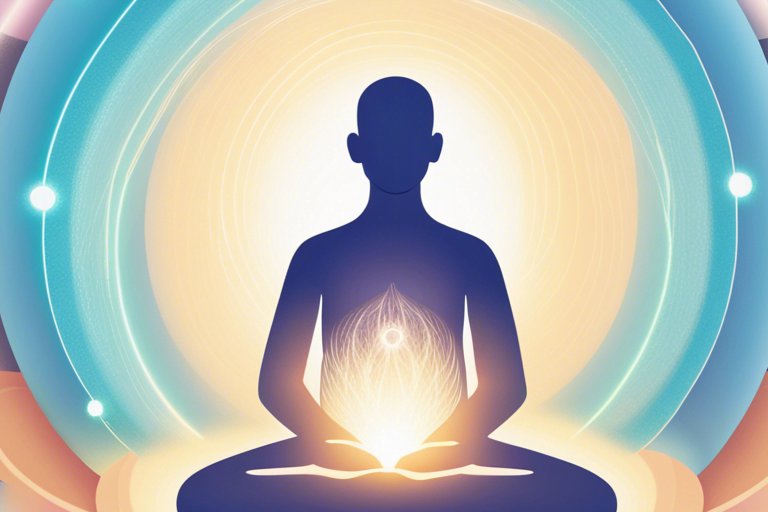Embarking on a spiritual journey is an enigmatic quest that merges the realms of psychology and spirituality. In this captivating blog, I navigate the intricate dance between the mind and the spirit, exploring the fusion of psychological wisdom with ancient spiritual traditions. From the depths of the human psyche to the scientific basis of meditation, this blog is a profound exploration of mindfulness techniques, cognitive behaviors, and the interconnectedness of all things. With a focus on mindful living, inner journeys of self-awareness, and traditions from around the world, this is a transformative space for personal healing and growth. Join me as we embark on a mystical journey of self-discovery and find solace in the convergence of psychology and spirituality.
Mindful Living
Introduction to Mindfulness
In our fast-paced and hectic world, finding moments of peace and stillness can be a challenge. This is where mindfulness comes in. Mindfulness is the practice of purposely bringing our attention to the present moment, without judgment. It involves being fully engaged in our experiences and sensations, instead of being caught up in our thoughts or worries about the future.
Benefits of Practicing Mindfulness
The benefits of practicing mindfulness are vast and encompass physical, mental, and emotional well-being. Research has shown that mindfulness can reduce stress levels, improve focus and concentration, enhance self-awareness, and promote a sense of overall happiness and well-being. By cultivating a mindful way of living, we become more attuned to ourselves and the world around us, leading to a greater sense of contentment and peace.
Mindful Eating and Cooking
Mindful eating and cooking can be powerful practices for enhancing our relationship with food and nurturing a healthy mind-body connection. By bringing mindful awareness to the process of eating and cooking, we can fully savor each bite, appreciate the nourishment our food provides, and make conscious choices about what we put into our bodies. This involves slowing down, savoring the flavors and textures of the food, and being present in the moment rather than being consumed by distractions or multitasking.
Mindful Breathing Techniques
One of the simplest and most accessible ways to practice mindfulness is through mindful breathing techniques. By focusing our attention on the breath, we can ground ourselves in the present moment and cultivate a sense of calm and relaxation. Deep belly breathing, for example, involves taking slow, deep breaths, fully expanding the lungs and diaphragm, and exhaling fully. This technique can help to alleviate stress, reduce anxiety, and promote a state of inner peace.
Incorporating Mindfulness in Daily Activities
Mindfulness can be integrated into every aspect of our daily activities, from brushing our teeth to walking to work. By bringing our full attention and awareness to each task, we can transform even the most mundane activities into opportunities for mindfulness. For example, while washing the dishes, we can feel the warm water on our hands, notice the sensation of the soap, and be fully present with each movement. By incorporating mindfulness into our everyday lives, we can cultivate a greater sense of presence, appreciation, and joy.
Inner Journeys
Exploring Emotions and their Role in Personal Growth
Emotions are a fundamental aspect of our human experience, and exploring them can lead to profound personal growth. By becoming aware of our emotions, we can learn to understand and navigate them more effectively. Emotions can serve as valuable messengers, providing insight into our needs, desires, and areas of growth. By embracing rather than suppressing our emotions, we can tap into their transformative power and use them as catalysts for personal development.
Understanding Unconscious Patterns and Beliefs
Many of our patterns of behavior and beliefs are deeply ingrained and operate on an unconscious level. These patterns can shape our thoughts, feelings, and actions, often without our conscious awareness. By bringing these unconscious patterns into the light of our awareness, we can begin to understand their origins and effects on our lives. This self-awareness allows us to challenge and reframe limiting beliefs, which can ultimately lead to personal growth and expanded possibilities.
The Power of Self-Awareness
Self-awareness is the foundation of personal growth and transformation. By cultivating a deep understanding of ourselves, including our thoughts, emotions, strengths, and limitations, we can navigate life with more clarity and authenticity. Self-awareness allows us to make conscious choices, align our actions with our values, and live in alignment with our true selves. It is through self-awareness that we gain insight into our patterns, triggers, and areas of growth, empowering us to make positive changes in our lives.
Practices for Developing Self-Awareness
There are many practices and techniques that can support the development of self-awareness. Meditation, journaling, and therapy are just a few examples. Meditation allows us to observe our thoughts and emotions without judgment, cultivating a non-reactive and compassionate stance towards ourselves. Journaling provides a space for self-reflection and exploration, allowing us to gain insights into our inner thoughts and experiences. Therapy offers a supportive and confidential environment where we can explore our emotions, behaviors, and beliefs with the guidance of a trained professional.
Transformative Role of Meditation and Reflection
Meditation and reflection are powerful tools for self-discovery and personal growth. Through meditation, we can quiet the mind, cultivate mindfulness, and develop a deep sense of inner stillness and peace. Reflection, on the other hand, involves actively contemplating our thoughts, feelings, and experiences, with the intention of gaining deeper insights. By integrating regular meditation and reflection practices into our lives, we can embark on a transformative journey of self-discovery, self-compassion, and personal growth.

Spiritual Sciences
Science Behind Spiritual Experiences
Spiritual experiences have long been a topic of fascination and inquiry. From the feeling of awe when witnessing a beautiful sunset to the sense of oneness with the universe during meditation, these experiences can be deeply transformative and transcendent. In recent years, science has started to explore the mechanisms behind spiritual experiences, shedding light on the neural pathways, brain regions, and physiological responses involved. This research is helping to bridge the gap between spirituality and science, offering a better understanding of the profound effects that spirituality can have on our well-being.
Neuroscience of Meditation
Meditation has been practiced for thousands of years, and its benefits for mental, emotional, and physical well-being are well-documented. In recent years, neuroscience has begun to unravel the mechanisms underlying the transformative effects of meditation. Studies have shown that regular meditation practice can lead to changes in brain structure and function, including increased gray matter volume in regions associated with attention, emotional regulation, and compassion. These findings provide scientific evidence for the power of meditation in promoting overall well-being and psychological flourishing.
Quantum Physics and Spirituality
Quantum physics, with its focus on the fundamental nature of reality at the subatomic level, has deep implications for spirituality. Both quantum physics and spirituality challenge our conventional understanding of reality, suggesting that there is more to the universe than meets the eye. Quantum phenomena such as entanglement and superposition point to the interconnectedness and non-local nature of reality, aligning with spiritual concepts of unity and interconnectedness. Exploring the parallels between quantum physics and spirituality can open up new avenues of understanding and bridge the gap between science and spirituality.
Exploring Energy Fields and Vibrations
Energy is a fundamental concept in both science and spirituality. In science, energy is described as the capacity to do work, while in spirituality, energy is believed to underlie all aspects of existence. Energy fields, such as the electromagnetic field of the body, are thought to play a vital role in our health and well-being. Practices such as Reiki and acupuncture work with the energy system of the body to promote balance and healing. By exploring the concept of energy fields and vibrations, we can gain a deeper understanding of the interconnected nature of the mind, body, and spirit.
Interconnectedness of Mind, Body, and Spirit
The mind, body, and spirit are intricately interconnected, each influencing and impacting the others. This holistic perspective recognizes that our mental, emotional, and spiritual well-being are intimately tied to our physical health and vice versa. When we neglect one aspect of ourselves, it can manifest as imbalance or dis-ease in other areas. By honoring and nurturing the interconnectedness of mind, body, and spirit, we can cultivate a greater sense of overall well-being and harmony. Practices such as yoga, tai chi, and mindfulness meditation can support this integration and promote a holistic approach to health and wellness.
Traditions Explored
Introduction to World Spiritual Traditions
The world is rich with diverse spiritual traditions, each offering its unique teachings, practices, and wisdom. From ancient indigenous practices to modern-day religions, these traditions provide guidance on how to live a meaningful and purposeful life. Exploring world spiritual traditions allows us to gain a broader perspective, deepen our understanding of different cultures, and tap into universal principles that can enhance our own spiritual journey.
Comparing and Contrasting Different Traditions
By comparing and contrasting different spiritual traditions, we can identify similarities and differences in their teachings and practices. This comparative approach allows us to recognize the common threads that run through various traditions and gain insights into the universal truths that unite humanity. It also provides an opportunity for personal reflection and discernment, as we explore which aspects of different traditions resonate with us on a deeper level.
Psychological Implications of Indigenous Spiritual Practices
Indigenous spiritual practices have been passed down through generations and offer profound wisdom and insights into the human psyche. These practices often involve rituals, ceremonies, and storytelling, which serve as pathways for connecting with the divine and one’s own innate wisdom. The psychological implications of indigenous spiritual practices can include healing trauma, cultivating resilience, and fostering a sense of belonging and interconnectedness. By exploring and honoring these practices, we can gain a deeper understanding of ourselves and our place in the world.
Sufism: The Mystic Path of Islam
Sufism is the mystical branch of Islam, characterized by its focus on inner spirituality and direct personal experience of the divine. Sufism emphasizes the cultivation of love, humility, and unity with the divine and all of creation. Through practices such as dhikr (remembrance of God), meditation, and whirling dance, Sufis seek to transcend the limitations of the ego and experience oneness with the divine. Exploring the teachings and practices of Sufism can offer insights into the transformative power of love, devotion, and mystical experiences.
Buddhism: Mindfulness and Enlightenment
Buddhism, founded by Gautama Buddha, offers profound teachings and practices for cultivating mindfulness, compassion, and enlightenment. At the core of Buddhism is the Four Noble Truths, which highlight the reality of suffering and the path to liberation from it. Through practices such as meditation, mindfulness, and ethical living, Buddhists seek to cultivate a deep awareness of the present moment and awaken to the true nature of reality. Exploring the principles and practices of Buddhism can provide valuable tools for finding peace, clarity, and liberation in our own lives.

Healing and Growth
Integration of Therapy and Spirituality
The integration of therapy and spirituality recognizes that healing and growth involve addressing both psychological and spiritual dimensions. Therapy provides a structured and supportive environment for exploring and working through psychological challenges, while spirituality offers a broader framework for understanding the deeper meaning and purpose of our experiences. By integrating therapy and spirituality, we can cultivate a holistic approach to healing, one that addresses the mind, body, and spirit.
Holistic Approaches to Healing
Holistic approaches to healing encompass a wide range of practices and therapies that address the whole person – mind, body, and spirit. These approaches recognize that physical symptoms often have emotional and spiritual roots, and vice versa. Examples of holistic healing modalities include acupuncture, aromatherapy, energy healing, and herbal medicine. By engaging in these practices, we can activate the body’s natural healing abilities and promote overall well-being on multiple levels.
Reconnecting with Nature for Personal Growth
Nature has an innate ability to heal and inspire us. By reconnecting with nature, we can tap into its restorative powers and experience a deep sense of interconnectedness with all living beings. Whether it’s through hiking in the mountains, walking along the beach, or simply spending time in a park, immersing ourselves in nature can rejuvenate our spirits, reduce stress levels, and foster a sense of awe and gratitude. This reconnection with nature can be a powerful catalyst for personal growth, self-reflection, and inner transformation.
The Power of Affirmations and Visualization
Affirmations and visualization are powerful tools for reprogramming the mind, creating positive change, and manifesting our desires. Affirmations are positive statements that we repeat to ourselves, often in the present tense, to reinforce positive beliefs and attitudes. Visualization, on the other hand, involves creating vivid mental images of the desired outcome or experience. By consistently practicing affirmations and visualization, we can shift our thoughts, beliefs, and energy, aligning ourselves with our goals and aspirations.
Exploring Past-Life Regression for Healing
Past-life regression is a therapeutic technique that involves accessing and exploring memories and experiences from past lives. Proponents of past-life regression believe that these memories and experiences can hold valuable insights and lessons for our present life. By exploring past-life memories, we can gain a deeper understanding of recurring patterns, unresolved issues, and karmic connections. This exploration can facilitate healing, clarity, and personal growth, as we integrate the wisdom and experiences from past lives into our current life.
Spiritual Practices in Daily Life
Morning Rituals for Spiritual Connection
Morning rituals provide an opportunity to start the day with intention, focus, and spiritual connection. Whether it’s through meditation, prayer, journaling, or gentle movement, incorporating a morning ritual into our routine can set a positive tone for the rest of the day. These rituals create a sacred space for nurturing our spiritual connection, cultivating mindfulness, and aligning ourselves with our highest intentions and values.
Creating Sacred Spaces
Creating a sacred space in our homes or workplaces is a powerful way to foster a sense of peace, tranquility, and spiritual connection. This can be as simple as designating a corner of a room for meditation or prayer, or as elaborate as creating an altar or shrine. By infusing our space with meaningful objects, symbols, and elements, we create a physical representation of our spiritual practice and create a sanctuary for reflection, contemplation, and renewal.
Journaling for Self-Reflection
Journaling is a powerful practice for self-reflection, introspection, and personal growth. By putting pen to paper, we give voice to our thoughts, emotions, and experiences, externalizing them and gaining clarity. Journaling provides a safe and non-judgmental space for exploring our inner landscape, processing our feelings, and gaining insights into our patterns and beliefs. By making journaling a regular practice, we can deepen our self-understanding and cultivate a greater sense of self-compassion.
Building a Daily Meditation Practice
A daily meditation practice is a cornerstone of spiritual growth and inner peace. Meditation allows us to quiet the mind, cultivate mindfulness, and connect with our inner wisdom and intuition. By carving out a specific time each day for meditation, we make a commitment to ourselves and create space for stillness and self-reflection. Consistency is key, and even just a few minutes of meditation each day can have profound effects on our well-being and spiritual development.
Practicing Gratitude and Compassion
Practicing gratitude and compassion are essential spiritual practices that cultivate a sense of interconnectedness, empathy, and joy. Gratitude involves consciously acknowledging and appreciating the blessings and abundance in our lives, while compassion involves actively extending kindness and understanding towards ourselves and others. By making gratitude and compassion a regular practice, we shift our consciousness from scarcity to abundance and from judgment to love, resulting in greater peace, contentment, and connection.

The Role of Faith in Psychological Well-being
Exploring the Relationship Between Faith and Psychology
The relationship between faith and psychology is a complex and multifaceted one. On one hand, faith can provide individuals with a sense of purpose, meaning, and hope, particularly in times of hardship or uncertainty. On the other hand, psychology offers insights into the workings of the human mind and provides evidence-based approaches for promoting psychological well-being. Exploring the intersection of faith and psychology can allow us to integrate these two dimensions of human experience and gain a deeper understanding of how they can support and enhance each other.
Benefits of Integrating Faith and Psychology
Integrating faith and psychology can offer numerous benefits for psychological well-being. Faith can provide individuals with a sense of belonging, community, and support, which can be particularly beneficial during times of stress or crisis. Psychology, on the other hand, can offer a framework for understanding and addressing psychological challenges, such as anxiety, depression, and trauma. By integrating the wisdom of faith with the insights of psychology, individuals can cultivate a holistic approach to well-being that addresses both the spiritual and psychological dimensions of their lives.
Navigating Doubt and Spiritual Crisis
Doubt and spiritual crisis are common experiences on the spiritual journey. Doubt can arise when our beliefs and experiences are challenged, and we find ourselves questioning the validity of our faith. Spiritual crisis, on the other hand, can occur when we experience a deep existential or spiritual struggle, often accompanied by feelings of confusion, despair, or loss of meaning. Navigating doubt and spiritual crisis requires patience, self-compassion, and a willingness to explore and question our beliefs and experiences. It can also be helpful to seek support from mentors, spiritual teachers, or therapists who can provide guidance and perspective.
Spirituality as a Source of Resilience
Spirituality can serve as a source of resilience, providing individuals with a sense of inner strength, hope, and purpose. In times of adversity, spiritual beliefs and practices can offer comfort, solace, and a sense of meaning. By cultivating a strong spiritual foundation, individuals can tap into their inner resources and navigate life’s challenges with greater resilience and equanimity. Spirituality offers a broader perspective, reminding us that we are part of something greater than ourselves and that our struggles are part of our growth and transformation.
Case Studies: Faith and Mental Health
Case studies provide real-life examples of how faith can intersect with mental health and psychological well-being. These stories highlight the ways in which individuals have found solace, healing, and growth through their faith practices. From cultivating mindfulness through prayer to finding support and community within religious communities, these case studies illustrate the transformative power of faith in the context of mental health. These stories can serve as a source of inspiration and hope for individuals who are navigating their own faith and mental health journeys.
Finding Meaning and Purpose
Understanding the Search for Meaning
The search for meaning is an inherent aspect of the human experience. We all yearn for a sense of purpose, the feeling that our lives have significance and that we are contributing to something greater than ourselves. This search for meaning can take many forms, from exploring our passions and interests to engaging in acts of service or creative expression. By actively seeking and cultivating meaning in our lives, we can enhance our overall sense of well-being, fulfillment, and happiness.
Transcending Ego for Spiritual Growth
Transcending the ego is a central theme in many spiritual traditions and practices. The ego, often associated with our sense of separate self and identity, can create suffering and limit our capacity for spiritual growth. By transcending the ego, we move beyond the confines of our limited self-concept and connect with a deeper, timeless, and more expansive aspect of ourselves. This transcendence allows us to tap into our inherent wisdom, compassion, and interconnectedness with all of creation.
Living a Purposeful Life
Living a purposeful life involves aligning our thoughts, actions, and choices with our core values and deepest aspirations. It entails identifying and embracing the things that bring us joy, fulfillment, and a sense of contribution. By honoring our unique gifts and passions, and living in alignment with our purpose, we can experience a deep sense of meaning and satisfaction. This can involve making conscious choices, setting goals, and taking inspired action towards our dreams and aspirations.
Balancing Material Success and Spiritual Fulfillment
Balancing material success and spiritual fulfillment involves finding harmony between our external achievements and our internal sense of well-being. It is possible to pursue and achieve material goals while also nurturing our spiritual growth and well-being. This balance requires a conscious awareness of our values, priorities, and intentions. By cultivating a healthy relationship with money, success, and material possessions, we can find the sweet spot where material abundance and spiritual fulfillment coexist.
Self-Reflection: Discovering Personal Values
Self-reflection is a powerful tool for discovering and clarifying our personal values. Personal values are the guiding principles and qualities that we hold dear and that orient us in our decision-making and behavior. By taking the time to reflect on what truly matters to us, we can identify our core values, such as integrity, compassion, authenticity, or service. These values can serve as a compass, guiding us towards a life that is in alignment with our true selves and bringing greater meaning and purpose.

Exploring the Power of Prayer
Different Forms of Prayer
Prayer is a common practice in many spiritual traditions and can take on various forms. From silent contemplation to recitation of sacred texts or chanting, prayer provides a means of connecting with the divine and expressing our deepest longings, gratitude, or petitions. Whether structured or spontaneous, prayer serves as a conduit for communication with the divine and can provide solace, inspiration, and guidance.
The Science Behind Prayer
Scientific research has started to explore the effects of prayer on physical and psychological well-being. Studies have shown that prayer can reduce anxiety, promote relaxation, and increase feelings of well-being and connectedness. Prayer has also been found to have positive effects on physiological markers such as heart rate, blood pressure, and immune function. These findings suggest that prayer can have genuine therapeutic benefits and offer support for the role of spirituality in fostering well-being.
Prayer as a Tool for Emotional Regulation
Prayer can be a powerful tool for emotional regulation, offering a way to process and express our emotions in a safe and sacred space. By bringing our joys, sorrows, fears, and hopes to prayer, we allow ourselves to be seen, heard, and held by a higher power. This act of surrender can provide comfort, solace, and a sense of release, allowing us to experience emotional balance and resilience.
The Role of Prayer in Manifestation
Prayer can be used as a tool for manifestation, providing a means of aligning our intentions and desires with the universe. By setting clear intentions, visualizing our desired outcomes, and offering prayers of gratitude, we open ourselves up to receive the blessings and opportunities that are in alignment with our highest good. This practice of prayerful manifestation allows us to co-create our reality and actively participate in the unfolding of our dreams and aspirations.
Developing a Personal Prayer Practice
Developing a personal prayer practice is a deeply individual and sacred process. It involves finding a form of prayer that resonates with our unique beliefs, values, and spiritual inclinations. This may involve exploring various prayer traditions, experimenting with different forms of prayer, and adapting practices to suit our own needs and preferences. By developing a personal prayer practice, we create a sacred space for connection, reflection, and transformation, fostering our spiritual growth and deepening our relationship with the divine.
Mysticism: Connecting with the Divine
Exploring Mystical Experiences
Mystical experiences involve a direct encounter with the divine or a transcendence of ordinary reality. These experiences can be characterized by a sense of unity, timelessness, expansion, and a deep connection with all of creation. Mystical experiences often defy rational explanation and can be deeply transformative and life-altering. Exploring mystical experiences allows us to tap into the transcendent dimensions of our existence and cultivate a sense of awe, wonder, and connection.
The Role of Meditation in Mysticism
Meditation plays a significant role in mystical practices across various traditions. By quieting the mind, stilling the ego, and opening the heart, meditation creates the ideal conditions for mystical experiences to unfold. Through meditation, we can transcend the limitations of the ego and enter into a state of expanded consciousness, where we can experience the interconnectedness of all things and commune with the divine. By incorporating meditation into our spiritual practice, we can create space for mystical insights, experiences, and transformation.
Ecstatic Practices: Dance, Chanting, and Breathwork
Ecstatic practices such as dance, chanting, and breathwork have long been used as vehicles for mystical experiences. These practices involve moving beyond the constraints of the rational mind and engaging the body, voice, and breath as gateways to the divine. Dance can be a form of ecstatic expression, allowing us to embody and channel divine energy. Chanting involves repetitive vocalizations of sacred sounds or mantras, which can induce altered states of consciousness and deep spiritual connection. Breathwork techniques, such as holotropic or circular breathing, can facilitate powerful experiences of unity, expanded awareness, and transcendence.
Union with the Divine: Oneness and Surrender
Union with the divine is the ultimate goal of mysticism, representing a state of complete unity, surrender, and oneness with the divine. This mystical union is characterized by a loss of egoic identity and a merging with the divine essence. It is a state of profound love, peace, and bliss, where the boundaries of the self dissolve, and all dualities cease to exist. While the experience of union with the divine is often fleeting and elusive, the glimpses of this ultimate reality can serve as profound sources of inspiration, transformation, and spiritual growth.
Integration of Mystical Experiences in Everyday Life
Integrating mystical experiences into everyday life involves bridging the gap between the transcendent and ordinary realms. While mystical experiences are often described as extraordinary or otherworldly, it is essential to find ways to bring their insights and wisdom into our daily lives. This integration can involve reflecting on the meaning and lessons of mystical experiences, incorporating spiritual practices and rituals into our routines, and cultivating an ongoing sense of awe, wonder, and gratitude for the divine in all aspects of life. By integrating the mystical into the mundane, we can infuse our lives with deeper meaning, purpose, and spiritual connection.

